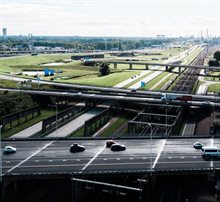The expected annual cost of upgrading civil infrastructure is going to increase from about €2.4bn per year for 2021 to 2030 to about €3.7bn by the end of the century, according to the national forecast report published by TNO last November.
In comparison, an estimated €1.1bn is currently spent every year on upgrading infrastructure, less than half of what projections say will be needed.
Another challenge here is that there are 377 civil infrastructure managers in the Netherlands, each one deciding when something needs to be replaced and making all the arrangements for that to happen themselves. The big question is: what concrete steps are needed to keep our infrastructure in working order, in both the short and long term?
Here are the main recommendations:
- Improve understanding
- Look ahead
- Increase urgency
- Address the challenge gradually
- Encourage collaboration
- Deploy innovative measures
Below, we elaborate on the recommendations.
1: Improve understanding
TNO's estimate is already a good first step to gaining a better understanding of how much work the continual upgrade requires. It is worth noting that these forecasts can become much more accurate.
‘But that really requires the input of all the infrastructure managers,’ stresses senior scientist at TNO Vector, Eldine Verweij. She has a business economics background and extensive experience in analysing investment issues. She has been instrumental in analysing the forecasts provided by 20 infrastructure managers.
‘Forecasts don't even have to be that comprehensive. But what is important is knowing the main aspects in the area under management, such as when infrastructure was built, the materials used, the number of square metres and other physical characteristics that may be important. That’s where it all starts.
If managers at least recorded that information required as a minimum, it would help enormously. And of course, it would be good to have a consistent approach to forecasting in future, where all managers work on the basis of the same assumptions.’
What should a forecast do as a minimum? ‘Basically, nothing too complicated,’ Verweij says. ‘Besides the points mentioned, it would be a huge help if infrastructure managers used the same units for costs when making a forecast. For example, what it costs to replace a metre of bridge railing. All managers should ideally use the same units for costs. At the moment, they don’t, making it difficult to compare forecasts.’
2: Look ahead
More than half of the forecasts provided did not look beyond 50 years or even 20 years ahead. Yet, the expected lifetime of certain infrastructure is generally 60 to 80 years.
A good prognosis therefore requires a horizon of at least 80 years,’ Verweij points out. ‘That too is essential to get a proper insight in the scope of the upgrades. At the moment, forecasts use different horizons. So, it would be good for infrastructure managers to adopt the same minimum horizon and assume certain reference lifespans, say 75 years for a non-moving steel road bridge. Now, that still varies a lot between managers.
But generally, it would make a huge difference if they adopted a similar approach to forecasting, so we can arrive at a national forecast that captures the scope of the upgrades increasingly accurately.’
3: Increase urgency
There are a total of around 377 civil infrastructure managers in the Netherlands, with the vast majority being municipalities. During the mapping exercise, it proved difficult to get hold of their current forecasts.
However, using data from the BTO (Basisregistratie Grootschalige Typografie: Basic registration: Large-scale Topography), TNO still managed to get an indication of the size of the task we are up against in the coming years and into the distant future, and what that means for infrastructure managers.
And it might look less rosy than we'd hope, says Alexander Bletsis, Innovation Orchestrator at TNO Vector and co-author of the report. ‘We strongly suspect that very few infrastructure managers appreciate the magnitude of the work needed to upgrade the infrastructure they are collectively responsible for. So, we hope our report serves as an eye-opener.
Every single manager, especially municipalities, needs to be really emphasising the urgency of this and bring the issue to the attention of those responsible for managing civil infrastructure.’
4: Address the challenge gradually
‘In the study, we have identified the nature and extent of the upgrade work needed, but that doesn’t yet give a picture of what we need to do to address it,’ Bletsis explains. ‘We make recommendations that provide infrastructure managers with courses of action, including suggestions to administrators and policymakers.
We hope the figures and conclusions in the report help make them aware of just how big the nationwide task ahead of them is. The report also suggests possible measures that infrastructure managers can implement right away to better respond to current and future challenges.
Not everything can be done at once, of course. That’s why we have underpinned the recommendations with a step-by-step approach. It starts with conveying the urgency and gaining better and more insight.
It then builds towards cooperation between managers and across layers of government, such as with a national programme similar to the Flood Protection Programme. We then conclude by applying and scaling up innovative measures that are already in development within the sector and can increase productivity.’
5: Encourage collaboration
One of the key recommendations is close cooperation between infrastructure managers in addressing the task ahead of them. There really is a lot to be gained in that area, says Peter Rasker, Mobility & Build Environment market director and author of the national forecast report.
‘By combining and standardising tasks and executing them based on industrialised processes, you can make huge efficiency gains. That is starting to emerge, but scaling up is essential to this huge task.’ Bletsis explains further, ‘There is so much civil infrastructure in the Netherlands. That alone calls for better coordination. Responsibility for 77% of upgrade work is decentralised (55% municipalities, 9% provinces, and 13% water boards) but there is little coordination with other managers... that says it all.
It’s like working on a large, tricky puzzle, where everyone can only see what pieces they have, but not the bigger picture. If that doesn’t change, we could well run into major problems when it comes to carrying out the upgrade work.
Meanwhile, there are changes in society that affect this, such as the nitrogen problem, conditions on the labour market, and the sustainability challenge ‒ not to mention management and organisation issues. So, we think it really is in the collective interest to ensure better alignment and cooperation.’
‘Of course managers are already cooperating and sharing knowledge to some extent,’ says Peter Rasker. ‘That’s nothing new. The challenge lies in the steps to increase the pace and scale. There are various forms of collaboration and organisation we can think of to achieve this. It depends on choices made by policymakers and managers, and what they deem important. In this kind of process, it’s important to build up a lot of knowledge about the nature and scope of the task and then, based on this, arrive at a common agenda.
In addition, you expect a different kind of cooperation at national level than at regional level. At regional level, there could be operational collaboration such as a programme-based approach between multiple administrators.’
‘Forming these kinds of collaborations is a complex process,’ says Bletsis. ‘The biggest challenges are not technical, but organisational ‒ not so much about the why or what, but how. There is still much to gain here in the sector, but more importantly, much to offer from the proposals developed by TNO Vector, together with Mobility & Built Environment. These form the basis for building collaboration, such as orchestrating innovation ecosystems and shaping sustainable industrial chains.’
6: Deploy innovative measures
Bletsis stresses the importance of supporting innovative measures that can be useful when it comes to upgrade work. ‘If infrastructure managers and market players continue to just do what they have always done, it might become very difficult to cope with all the upgrade work needed in the coming decades, which could even turn out to be impossible. So, it starts with greater understanding, but it also requires a new approach.’
It is clear that if we don’t have a clearer picture of what we already have, then there cannot be a targeted approach, says Bletsis. ‘For example, it’s best to focus on renovation first, instead of opting for replacement straight away. This is also the most sustainable option, after all. Plus, it’s useful to group similar structures and tender them out at the same time. This could even be done in close cooperation between different infrastructure managers. This will help shape a programmatic approach at regional level.’
According to Bletsis, the project-driven approach is currently the most common in the sector, which brings its challenges. ‘Once demand is organised into projects and each unique demand is tendered out one-by-one, we still have a problem with the feasibility and affordability of the work. A programme-based approach can really meet the demand in a different way.’
As soon as there is no prospect of continuity, this greatly affects the market’s willingness to invest in innovation and take risks. It’s important to standardise where there is great potential, especially for the many functional designs, Bletsis explains. ‘The sector is driven by demand from individual governments managing infrastructure. They are all autonomous, with their own policies, budgets and infrastructure make-up, which results in different management systems and ultimately makes demand look different. So, the tender procedure cannot be reproduced for other projects because nothing is standard and everything is considered unique.’
In short, there is much to be gained by increasing sector productivity and reducing transaction costs and lead times for current projects. At the same time, upgrade work is also accompanied by other challenges, namely the transition to climate-neutral and circular infrastructure, and the increasing scarcity of personnel and raw materials. To cope with this build-up of tasks, a different approach will have to be pursued, not only for demand but also for supply.
A serial and industrial approach for both renovation and replacement helps to flesh out this programme-based way of working and is seen as the best bet for ensuring productivity gains can made. ‘Supported by further digitalisation, this approach can help us learn more about what we already have, keep what works well and replace what isn’t working with circular solutions, through better economic incentives and greater efficiency.’
Ultimately, system innovation is not so much about developing new innovative measures, but in particular about applying and scaling up tried-and-tested innovative measures by changing the
architecture of the system. There are several barriers to innovating within the industry and supporting it beyond the pilot phase. We need influential mechanisms to adopt, implement and scale up innovative concepts (both technical and societal). Therein lies the crux, as the first steps are difficult to achieve because the usual project-based way of working does not align well with a more industrial approach. What is needed is structural change in the industry: another way of organising supply and demand, another way of looking at our civil infrastructure. This change will have to happen within government authorities and market players alike.
Want to know more? Contact us.

Peter Rasker
TNO director of Market, Mobility & Built Environment.

Alexander Bletsis
Innovation Orcherstrator, TNO Vector

Eldine Verweij
Senior scientist, TNO vector



